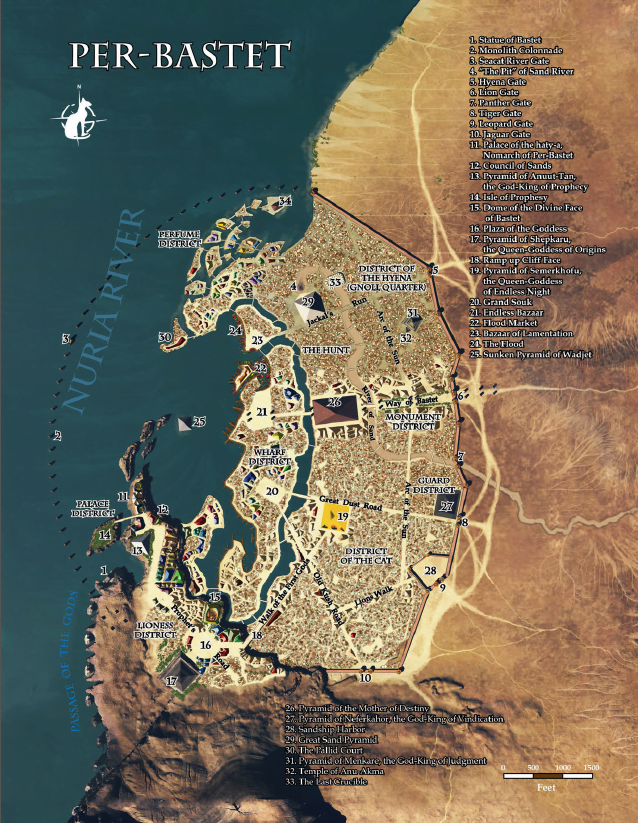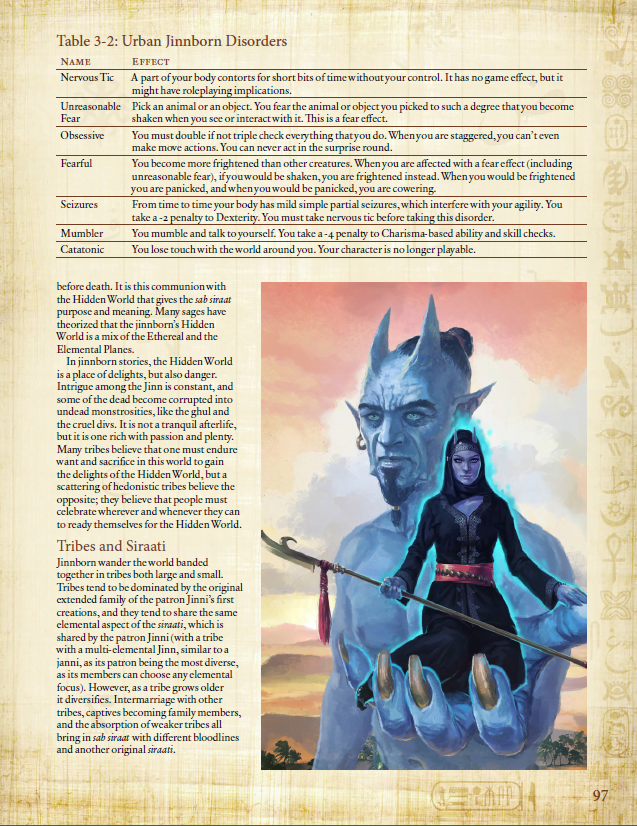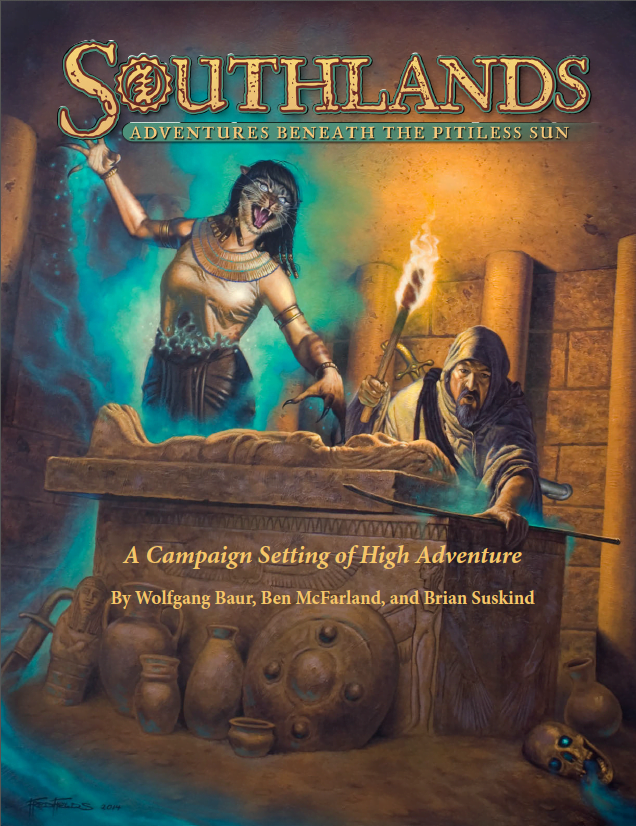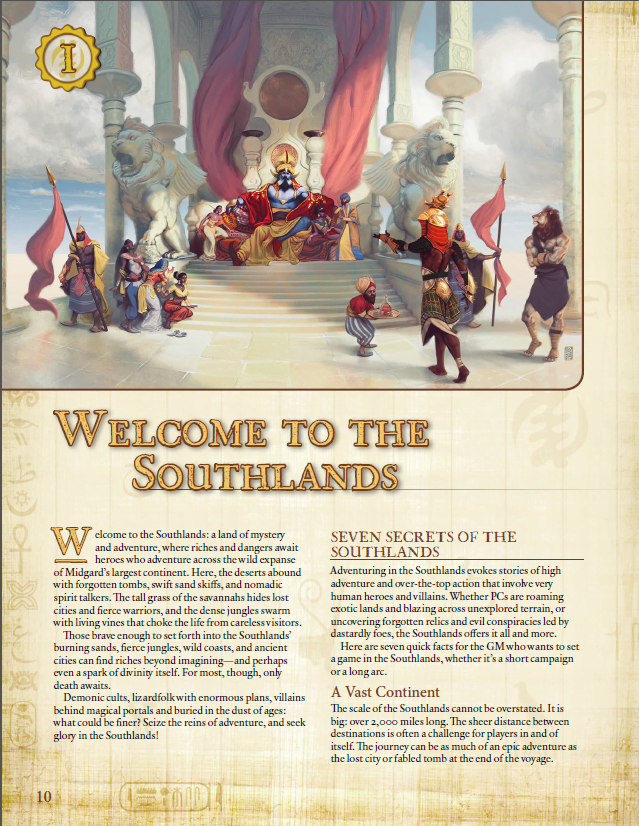Description
The Southlands – Realm of Mystery and Adventure
Southlands Campaign Setting offers everything you need to have legendary adventures in a sprawling continent of wealthy desert empires, demon-haunted jungles, and vast savannahs where gnolls and werelions hunt.
Featuring the talents of Wolfgang Baur (Midgard Campaign Setting, Al-Qadim), Ben McFarland (Streets of Zobeck) and Brian Suskind, this 300-page setting book includes:
- New character options for Pathfinder Roleplaying Game, with five new PC races—Gnolls, Kijani, Nkosi, Tosculi and Trollkin—plus seven minor races
- New magic items and spells, from flying carpets to lotus magic and hieroglyph magic
- New foes, perilous locations and deadly hazards, including the Orcs of the Green Abyss, the Corrupted Pyramid of Khensu, the Sorcerers of Nangui, and mummified monkey swarms
- The many gods and demons of the Southlands: Anu-Akma , Ogun, Thoth-Hermes, Eshu, Set and more
Here are enough kingdoms, treasures, monsters and adventure hooks to provide years of gaming in the deserts, jungles and tropical mountains. Use Southlands with the Midgard Campaign Setting, or bring its cities, lore, creatures, and characters to any campaign.








Zimriel –
I am amazed there are no reviews here for this work of genius, especially one that is now a “silver” Ennie winner.
Anyway: game designers have attempted non-Western settings almost since they’ve attempted Western settings, and with the Near East and the Far East they’ve generally done okay. The settings which have stubbornly resisted such attempts include India, Mesoamerica, and Africa. Why that is, I do not know. This, in my Algerian opinion, is the first setting to get Africa right.
The Sense Of Wonder aspect is off the charts. This is a continent with a whole living cancerous jungle in it. A raxasha ruling the paradise of the damned. A southern coast which is just too strange for words.
And don’t worry about “but I can’t roleplay an African” or “won’t I just be a foreigner in every place here”. That won’t be a problem. The Southlands make an immense place with Berbers – excuse me, Tamasheq – in the north [ob.Berber nitpick: probably should be Amasheq, I think Tamasheq is female and/or the language], colonists in the south and traders all up and down the coast. Your party will find a niche here.
So yes – this is great stuff. Especially if you like the Arabian Nights’ travel-stories or “King Solomon’s Mines” or, er, “Heart of Darkness”.
Endzeitgeist –
An Endzeitgeist.com review
#7 of my Top Ten of 2015!
This massive campaign setting-style book clocks in at 302 pages, 1 page front cover, 2 pages of editorial, 4 pages of ToC, 2 pages of KS-backer thanks, 1 page SRD, 1 page advertisement, 1 page back cover, leaving us with a massive 290 pages of raw content, so let’s take a look!
I was a (hesitant) backer for this book’s KS, but otherwise unaffiliated with the production of this massive tome. My book is mainly based on the print version, though the electronic version was consulted for the purpose of determining electronic functionality of e.g. bookmarks and the like.
What do I mean by “hesitant”? Okay, before we dive into this book’s subject matter, a brief history lesson: I consider myself a pretty faithful fan of Kobold Press, ever since it was Open Design -I own literally every supplement and even have, back when I actually wasn’t dirt poor, acted as a high-level-patron to get my very own special, unique module. I *really* like Midgard and the evocative potential Kobold press brings to the table. Alas, Deep Magic, the previous big book, was a heartbreaking exercise for me (see my review of that book) and it took, frankly, quite some prodding to dive in. I had a minor windfall and invested that, back in the day, in this book, as a kind of “make it or break it”-test. Did it pay off? Let’s see!
The Midgard campaign setting’s allure, so far, did lie primarily in its dark fantasy Germanic/Slavic flair, somewhat expanded upon by the Argonaut-style adventuring in the Journeys-books, but yeah – the focus was arguably euro-centric and thus, I was very much interested to see how the respective mythologies and power-dynamics would interact with the massive Southlands. The first thing you’ll notice, though, is that the structure and organization of this book eclipses that of Deep Magic by leaps and bounds: We begin this book with a deatiled history of the Southlands – and it is a glorious read.
No, really – I mean that – the history as presented already takes you right into this book’s world; it’s prose is evocative and makes you remember immediately what you wanted, what you craved in fantastical settings. Still, this is the general history, the time-line. The book also is suffused by small sideboxes, where an in-character narrator provides quotes as a guide and adventure hooks/bucket-lists for adventurers for the respective regions can be found. The book also provides 5 general, new races that can be found throughout the Southlands: Gnolls, Trollkin, Tosculi (see the advanced races-installment for more on the wasp-people), Nkosi (feline shape-changer humanoids) and Kijani (plant humanoids that seek to become mammalian). The races themselves are pretty powerful (plant-immunities, for example), but not excessively so – they should work within the context of most fantasy games, though, if your gunning for gritty gameplay, you may want to take a close look at them. An innovation used here for the first time (for the tosculi exclusively) and later expanded in the Advanced Races Compendium is advice on racial scaling – so yes, you can scale down the tosculi by a bit, though imho the race does not require this in all but the grittiest of games. On a nitpicky side, some races are “lopsided” with attribute bonuses allocated to physical attributes, so if you’re like me and prefer your races with a strong suit in both physical and mental attributes, that may be something to be aware of.
It should be noted that ethnicities of regular races as well as age, height and weight tables are part of the deal here. Now the interesting component here, ultimately, does not lie in the crunch (though it is significantly more solid – kudos to the authors! The intriguing component, however, would be the seamless and smart integration of literally thousands of years of history within the mythology of Midgard as a whole – whether it’s the origin of Boreas, the frigid northern wind and the tie to the survivors of sunken Ankheshel or Umbuso, the ancient empire of titans, fleeing from the domains of Wotan – the most intriguing aspect here is that this massive continent of pure historicity manages to weave its meta-narrative seamlessly into the overall context of Midgardian mythology, extending the diversity and organic feeling of the world by leaps and bounds. An interesting component is also how mythic rules are handled – as a basic tenet, they are considered to be the effects of remnants of divinity sparks, left behind by fallen pantheons and titans, which provides a nice in-game rationale for the existence of powers like that.
Now, it is after this that we focus on the first overall region, which would be Nuria Natal, the eternal realm – Nuria Natal, at first glance, seems very much like the pseudo-Egyptian realm, but it is distinct from e.g. Osirion and Khemit or similar realms in several key aspects, the first of which is the focus on the river that defines it – springing from a planar rift of the world-tree Yggdrasil, it blends the mythologies of the Nile and Midgardian theology in a truly distinct and unique vision. Similarly, the trope of undying godkings has a twist that goes far beyond what you’d expect – the legendary rulers of the land, semi-divinities and halfgods, have achieved a sense of immortality and may return from the grave to vanquish the foes of Nuria Natal, thus also explaining why the powerful, draconic sultanate Mharoti has failed to conquer this powerful nation. Similarly, the gods, while utilizing the themes of real world mythologies, never feel like simple carbon adaptations of real-world mythology, instead acting as a properly woven-in essential component of the vista portrayed.
Nowhere does this become more apparent than in Per-Bastet, the city of the everlasting cat, home of the deity…and basically a modern metropolis seen through the lens of the fantastic: A distinct patriotism unifies the quarters and their diverse residents, which contains gnolls and catfolk in abundance alongside werelions; from planar alleyways to a churning river of elemental-inhabited sand making its way through the chaotic jumble of the metropolis, the influence of Bastet, her church, the god-queen and her agents or the vampiric masterminds in the shadows, the vision of a true melting pot of fantastic ethnicities resonates with a character one usually only ascribes to real world cities. The writing here is impeccable and, much like the entries on a certain city and its necropolis, the staggering panorama extends in its quality throughout the whole chapter – from sandships as a vehicle-modification to a well-written ecology of the mummy (with ample variants and death curses), this chapter is abask in inspired writing and makes the places jump forth from the pages – whether they be the aforementioned places or the Ghatazi salt pits or the dreaded city of Per-Anu, devoted to ending lives in all manner of ways. The church of Aten and its diverse teachings, variant mummies, a city of undead and 4 archetypes (including archetypes for Theurge and White Necromancer) as well as a 10-level-PrC complement this chapter. While not universally awesome and sporting some minor deviations in rules-language, the content herein still is rather solid and well-ingrained within the context of the world. The book also sports multiple nice traits for further customization. The book also sports a HUGE number of hieroglyphs – these work akin to how rune magic or ankeshellian glyph magic work – and, while powerful, their limitations per associated cult do offer a rather easy way for the GM to control their availability – want that trick only followers of Anu-Akma have? Well, you better buckle up and join that organization!
The second, massive chapter details the nation under the auspice of the remaining wind lords, the same entities that sent Boreas packing with his aspirations of genocide – but that does not mean these eternal lords of the lands are kind – far from it. Their description very much makes clear that these elemental spirits do not adhere to the same morality as mortals. It is also in this domain that the twin lands of the gnolls (with a delightfully nasty gnoll-tactics sidebar) can be found. What do I mean by these? Well, here’s an entry: “Three words: leucrotta sorceror chieftain.” If you’re like me, this made you grin from ear to ear. The pages chronicling these harsh regions also tell of a depressed sphinx and her honor guard watching over the verdant ruins of a fallen empire and of the fate of Roshgazi, minotaur-nation and Catharge-equivalent – the nation has been razed to the ground by Mharot’s might, but in the ruins of this place, the sentient maze still draws visitors inside, hoping for salvation…before its other personality comes to the surface – and the “Broken” does not take kindly to intruders…
Goblin-occupied Mardas Vula with its black pyramid still exerts a lure on others and, wandering the sands, a colossal dire camel prophet sports howdah-like gnoll-encampments. The jinnborn race hearkens back to the genasi or planetouched and can be pictured as the elemental-themed mortals and the race sports quite a diverse and well-crafted array of options, including limited protection versus one’s element, endure elements and elemental blasts that can be upgraded via feats. That being said, this is very much a strong race, stronger than the “core”-races of the book, so take care when using them. At the same time, I thoroughly enjoyed their unique psychology and culture…but still. At their pretty high power-level, I wished more abilities were alternate racial traits instead of jamming all those abilities into the base frame of the race. The archetypes here are interesting – an elemental-themed paladin, gnoll caravan raiders and janni-calling summoners can be found and a PrC depicting the elite guard of aforementioned sphinx priestess is part of the deal. The chapter, like those before and after, also sports several unique spells and magic items – the latter of which deserve special mention, after all, we get an enchanted bed of nails and several unique carpets. One belt should be eyed very carefully, as it lets you pilot willing outsiders, fusing your body with them, which is exceedingly powerful when not handled with care.
Beyond the dominion of the wind lords, the book finds its full-blown stride with the high jungles, where access to the fabled well of urd can be found, as powerful aeromancers guard the Black Lotus Mesa as intelligent white apes afflicted with arcane wasting prowl the jungles. More unique and perhaps one of the most awesome and disturbing components of the whole book would be the fact that an Old One, verdant and all-consuming, ever-growing, extends its tendril’d reach beyond the confines, ever seeking to mutate and grow – it should then come as no surprise that the nation of Kush has, in efforts to stem the tide, turned to all manners of magicks most dark – but it may not be enough, as the corrupted Kijani that couldn’t escape its influence spread spore pods far and wide, creating horrid tendril slaves. The chapter also is a JOY to read due to an actually neat aeromancer archetype and, more than that, due to the vast array of hazards and the 8 lotus-types, which act as addictive, yes…but they also serve as powerful power components. This chapter is twisted, inspired and absolutely glorious.
The kingdoms of salt and steel, bustling and defined by commerce – here, the land of serpent-scholars beckons, while in the land of ancients, the living reliquaries roam. This section is not only brilliant for its take on themes usually not represented – a royal mythic naga lich rules over Ankhrimari, while the Narumbeki legions with their battle tactics and unique combat options represent a powerful militaristic force – the themes evoked here are seldom seen, borrowing heavily from Africa’s mythologies, with magical masks and awesome incantations sweetening the deal, while powerful combat divinations make for a unique and compelling magical tradition.
On the Corsair Coast, the holy city Shuruppak beckons, while the city of Sar-Shaba contains horrific demonic legions, warded and sealed await intrepid adventurers. The fabulously wealthy island nation of Shibai and wicked corsairs can be found…but there is also the happiest land, Kesara, realm of the saffron rajah, where everyone smiles – a smile of desperation and fear, for the tyrannic rajah of the land is capricious and nasty indeed – a realm devoted to the decadence of the horrible rakshasa master that sits bloated on its throne. Fiercely meritocratic lion kingdoms of Omphaya, led by a returned titan and his rakshasa vizier may not be a nice place to visit either. – but it sure should prove interesting.
The heartlands of the Southlands, the abandoned lands contain vast stretches of desert – it is here that the massive, black towers of the disturbing hive-cities of the tosculi can be found. Why disturbing? Well, there is one that consists of the resin-hardened corpses of the fallen. Yes. Awesome and so perfectly evocative. Someone has also probably read China Miéville’s excellent “The Scar”, for there is a floating city in the style of Armada to be found. Mechanically, these lands are brutal, as the web of ley lines is damaged, which makes primal magic rather powerful…and excessively dangerous. The long-limbed Ramad are a balanced race sported here and significant ley line magic expansions and delightfully disturbing living tosculi items complement this evocative, harsh land as we turn our gaze southwards, to the fringe of the southlands, where dinosaurs roam and the minotaur nation of Sudvall stands guard. The xorn sultanate of Zanskar can also be found here…and should you hesitate to set a whole campaign in the southlands…did you know that one particular bottle contains a whole city of assassins? Yeah…if you don’t come to the Southlands, they may well come to you.
The pdf’s last chapter is devoted to the pantheons and gods of the Southlands – and their depictions are inspired, utilizing concepts and names from real-world mythology, but putting a thoroughly unique spin on them. The book concludes with an equipment table as well as a feat-index. My copy also sports a truly superb, glossy poster-map of the gorgeous cartography.
Conclusion:
Editing and formatting are top-notch for a book of this size – while I did notice an instance where the page-reference was still the layout-stage’s “$$”, the crew of Kobold Press has done a vastly superior job when compared to Deep Magic; the formal editing is more than solid and while I consider not all crunchy bits to be perfectly balanced, the rules-language is significantly more precise than in Deep Magic. Layout adheres to a 2-column standard in full color and is absolutely stunning; much like the lavish amount of original full-color art, the aesthetic components render this book frankly one of the most beautiful RPG-supplements I own. The pdf comes fully bookmarked. The hardcover uses high-quality, thick, matte paper and glossy, high-quality paper for the huge map. The cartography of the book is superb for the most part, though some of the more ruined cities look “only” very good – still, overall, this is one of the most beautiful books you’ll ever see.
Wolfgang Baur, Eric Cagle, David “Zeb” Cook, Adam Daigle, Dan Dillon, Amanda Hamon Kunz, Steven T. Helt, Steve Kenson, Ben McFarland, Richard Pett, Marc Radle, Stephen Radney-MacFarland, Ted Reed, Stephen Rowe, Adam Roy, Owen K.C. Stephens, C.A. Suleiman, Brian Suskind, Henry Wong – ladies and gentlemen, congratulations are in order.
You see, Golarion and similar setting have often drawn upon the tropes of Arabian nights and pharaonic Egypt – but never this way. The creative approach to this book could be summed up as follows: The book took the classic real-world mythologies that resonate with us and put a spin on it – so far, so common. However, the true excellence of Southlands lies not within this; no. The massive achievement of this book lies in the concise manner in which it brings the truly fantastic to the table and treats it seriously; the Southlands feel alive and concise, because it takes a very much logical, concise approach to world-building – whether as stand-alone or as part of the Midgard campaign setting, the Southlands excel. The blending of mythologies and use of more obscure themes collides with pure imaginative potential in a true, creative firework. I wouldn’t have expected this book to be that great a read – as a huge fan of Catherynne M. Valente’s “Orphan’s Tales”, my bar for myth-weaving is ridiculously high…but here’s the thing: I loved reading this book. Much like the best of mythpunk novels, much like the most inspiring of fantastic novels, this tome is a true page-turner and contains more imaginative potential than just about every setting I could list. This is not Al-Qadim v. 2.0. – it surpasses this excellent classic and mops the floor with it.
Now granted, I am not sold on all design-decisions herein, not perfectly convinced regarding the balance of some components – but all of that ultimately pales before a book that is true excellence. I haven’t enjoyed reading a campaign setting this much since the original Midgard Campaign Setting and honestly, enjoyed this book even more – because it takes less familiar concepts, because it brims with the spark of genius and more evocative locations than multiple settings combined. There is not a single campaign setting book that is comparable in scope and ambition and, better yet, while not all the crunch reaches the constant, almost frightening level of genius of the prose, there are ample instances where I simply fist-pumped – the lotus-magic is pure awesomeness and similarly, quite a few of the magic items just feel magical, unique, awesome…and the hazards…oh boy, do I love me some hazards!
Here’s the most important component, though: Beyond simply being a superb read and surprisingly, in spite of heavily quoting real world mythologies, Southlands is a book of jamais-vus, of the novel and still familiar, an accumulation of brilliant ideas that practically DEMAND that you run modules, campaigns, whole APs in this wondrous, exceedingly captivating setting. My only true gripes while reading this tome pertained to the organization of player-material – out-sourcing that to a Player’s Guide would have probably been a prudent move – but I’m ultimately just nitpicking. If anything, just about every nation herein made me crave more; each chapter made me want a whole AP set in it so bad… Southlands is a furious return to form for Kobold Press. This book very much shows how and why Kobold Press became as popular as it now is – even if you’re not actively gaming, this is well worth buying: Flip open those pages, start reading and dream a dream of harsh jungles, enchanted deserts and gorgeous cities, both bustling and ruined, of a savage land of splendor and glories untold. Go to the Southlands. Get this book. Dream. There are very few books of this size that manage to maintain a sense of narrative consistency, much less at the thoroughly impressive level of quality the ideas in this tome have.
This may well be the best sourcebook Kobold Press has released (I’m a fanboy of some adventures…), perhaps this is even one of the best sourcebooks I’ve ever read. If anything, I do hope that Northlands at one point get a similarly detailed second edition. Southlands is excellence – if you even remotely are interested in the subject matter, do yourself a favor and get this glorious tome – it contains enough ideas and adventure for a lifetime and I am not engaging in hyperbole here. My final verdict will clock in at 5 stars + seal of approval and I’ll also nominate this as a candidate for my Top Ten of 2015. (Scheduled for release soon!)
Endzeitgeist out.
RIC MOHRI –
This is one of the best southern continent setting for any of the campaigns that I have run. It has a rich history on on the continent came into being, the gods/goddesses of the continent and countries. There are lots of new archetypes, prestige classes, feats and spells that fit the Midgard Campaign. I also love the core character races. The Kobold Press team hit a homerun on this one.